Slasher Spotlight: A Horror Genre Tries To Make Its Mark on Games
Mike takes a look at the slasher genre and a few of the titles in a growing wave of upcoming horror games. [Warning: Blood and stuff.]
This article first appeared on USgamer, a partner publication of VG247. Some content, such as this article, has been migrated to VG247 for posterity after USgamer's closure - but it has not been edited or further vetted by the VG247 team.
The slasher genre is making a comeback.
Well, the genre never really left, but it does take up less of our mainstream consciousness. Slasher movies have fallen off from their heyday in the 70's and 80's, when big-screen slasher flicks commanded top dollar, and horror icons like Jason, Freddy, and Michael Myers were created. Horror still sells, but these days it's of the found-footage or haunting variety. There's little in your local cineplex featuring one deranged person with a love of sharp objects and a desire to kill others.

The genre is looking to make a new mark on our hearts and minds, but the interesting thing is the push isn't focused in Hollywood. We're celebrating the 35th anniversary of the original Friday the 13th, but the only major slasher film releasing this year is the horror-comedy The Final Girls. Instead, other mediums are picking up the slack. In television, MTV is preparing to launch a series based on the 2000-era slasher hit Scream and Fox is readying Scream Queens, a campy slasher series from American Horror Story creator Ryan Murphy. Even Jason Voorhees is getting in on the TV action with a Friday the 13th series in development.
That's little compared to what we're seeing in the gaming industry. These are the titles that have already released or are coming within the next few years:
- Lakeview Cabin Collection - Roope Tamminen
- Slasher Vol. 1: Summer Camp - Gun Media
- Until Dawn - SuperMassive Games
- Project Scissors: NightCry - Playism Games
- Last Year - James Matthew Wearing
- Friday the 13th - Crystal Lake Entertainment
- Power Drill Massacre - Puppet Combo
That's seven titles all coming within the next year or so. Some are single-player, some are multiplayer, some are small indie projects; all of them harken back to a different era of cinema. Why are all these games coming out now? Why are all these developers focused on the slasher genre? Is it simultaneous conception, the current zeitgeist, or did a number of factors just come together to build this trend?
I spoke with the folks behind three of the titles mentioned above - Lakeview Cabin Collection, Summer Camp, and Until Dawn - trying to understanding why the slasher genre was enticing to them and how they plan to stick out amongst their competitors. You'll find those spotlight articles of subsequent pages, or you can jump directly there from the links above. But before we get there, let's attempt (and fail) to define the genre itself.

What is a Slasher?
This is one of those widely debated questions, with many people leaning on the old standby, "I know it when I see it." As a subset of the horror genre, slasher films are usually concerned with an unrelenting force that murders a number of hapless victims, usually with a bladed weapon of some sort. Sometimes the killer is unknown to its victims, but the most popular slasher films tend to have a known, iconic murderer. Scholar Vera Dika explicitly defined slasher films with her "stalker cycle": a community commits a wrong that incites a killer, the killer returns after that community observes that wrong, and the young perish, until our heroine or hero puts the killer down or escapes. (This is expanded in her book, Games of Terror.) Women tend to be the lone survivor at the end, which lead to the genre trope of the Final Girl.
Dika goes further in noting that many films tend to give us the killer's viewpoint without characterizing that viewpoint; we see their victims through their eyes, but lack insight into why they are killing. In fact, the killer tends to stay offscreen for most of the opening entries in slasher films. Despite that, slashers from the 80's tended to play up the murderer; audiences were there for Jason, Leatherface, or Michael Myers, not their victims. Dika is more formalist than others who attempt to define the slasher, stating that the "stalker film" trend began with John Carpenter's Halloween in 1978 and lasted for around 4 years
Others are more open in their definitions. Carol J. Clover is the one who coined the term, "Final Girl", and she's a bit more open in her classifications. In her essay, "Her Body, Himself: Gender in the Slasher Film", she begins with Alfred Hitchcock's Psycho as the immediate ancestor of the genre.
"Its elements are familiar: the killer is the psychotic product of a sick family, but still recognizably human; the victim is a beautiful, sexually active woman; the location is not-home, at a Terrible Place; the weapon is something other than a gun; the attack is registered from the victim's point of view and comes with shocking suddenness," Clover wrote.
That definition allows us to pull in films like Texas Chainsaw Massacre, a film that falls outside of Dika's classifications, and even reach backwards to previous eras in film. The truth is the slasher occupies a grey area between a criminal thriller and a splatter or torture porn film. Trying to rigidly classify a slasher is difficult; like religion, everyone has their own interpretation. Part of that is because of the disparate origins of the genre.

The History of the Slasher
So where the hell did the slasher come from?
Some point back to Le Théâtre du Grand-Guignol, a theatre in Paris that specialized in graphic horror plays. From 1897 until it closed in 1962, the Grand Guignol played host to some amazingly gory plays with realistic special effects. The theatre's works inspired early splatter films, a horror genre that relies on graphic gore, but similar tropes can be found in slasher films.
Others point the finger at real-life serial killer, Ed Gein, who confessed to killing and mutilating two women and robbing nine graves in Plainfield, Wisconsin in the later 1950's. Gein's actions and life were the inspiration of Robert Bloch's 1959 novel Psycho, which in turn inspired Alfred Hitchcock's film of the same name. The film was released in 1960 and is considered by many to be one of the early examples of the slasher genre.

In the early 60's, the genre would pop up in the United States and abroad. Overseas, the Italian Giallo films were crime thrillers that played up violent, stylized horror and sexuality. Mario Bava directed Blood and Black Lace, a landmark entry for the giallo trend. The film was released in 1964; its masked stalker and sexual leanings were a hit and paved the way for later giallo films. Director Dario Argento, inspired by Black Blood and Lace, created The Bird with the Crystal Plumage in 1970, which turned giallo into a bonafide cultural phenomenon. Bava's most violent giallo film came in 1971 with Twitch of the Death Nerve, which was controversial at the time, but was later hailed as a pioneering effort. Sergio Martino, who started out directing documentaries and exploitation films, released Torso in 1973, featuring many of the ideas we'd find common in later slasher films: a masked killer with a wounded past murdering young female college students, culminating in our final girl. Giallo dominated Italian audiences until the trend began to decline in the later 70's.
Around the mid-70's in the US and UK, the exploitation film craze began to give way to the beginnings of the slasher film golden age. In 1974, Tobe Hooper's Texas Chainsaw Massacre and Bob Clark's Black Christmas began to lay down a formula that would be repeated in later films. Black Christmas finds a group of sorority sisters alone in a house with a serial killer during the holiday season, while Texas Chainsaw Massacre featured Leatherface, one of the early iconic slasher villains.
Black Christmas would later inspire John Carpenter's Halloween, which released in 1978. Halloween became a critical and commercial success, establishing a number of imitators in the process. Carpenter wrote, directed, and composed the soundtrack for the film, which was budgeted at a mere $300,000. The masked Michael Myers, scenes from the killer's point of view, the sex-equals-death trope, the final girl (played in her debut by Jamie Lee Curtis), and the low-budgetness of it all; a number of slasher genre tropes were codified here. Halloween was filmed in 20 days with Carpenter cutting corners wherever possible, but it ended up making $47 million domestically. Like 1999's The Blair Witch Project popularized the found-footage horror film and showed studios there was money to be made in the genre, Halloween did the same with the slasher film.
Studios rushed to make their own slashers with mixed success. Two years after Halloween, Friday the 13th became the right hook the genre needed and one of its biggest standouts. Critics hated the over-the-top violence in the film - famous critics like Gene Siskel, Roger Ebert, and Leonard Maltin mercilessly panned it - but audiences loved the hell out of it. Halloween showed that a slasher could be a success and Friday the 13th's repeat of that success showed Hollywood there was money to be made. Paramount loved that slasher money so much that Friday the 12th Parts 2 and 3 came only a year apart.
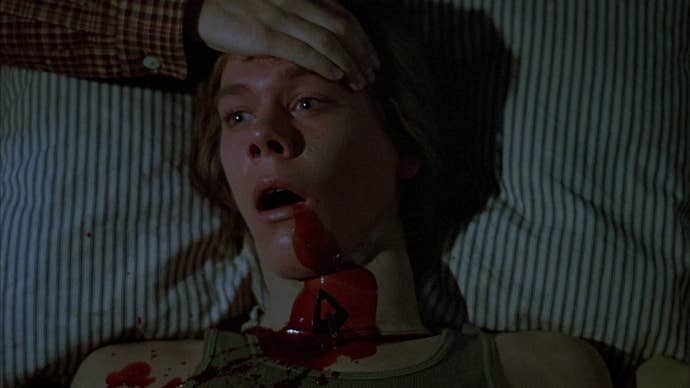
By 1985, the genre's popularity in movie theatres had declined due to a glut of available films, but home video allowed the genre to carry on. The mid to late 80's saw a ton of no-budget horror films and sequels in the Halloween, Friday the 13th, and Nightmare of Elm Street franchises. 1989 was the killing blow for all three franchises, with Friday the 13th Part VIII: Jason Takes Manhattan, Halloween 5: The Revenge of Michael Myers, and A Nightmare on Elm Street 5: The Dream Child all failing to perform for studios.
Hollywood tried to keep the dream alive, but nothing quite made its mark until 1996's Scream, which relied heavily on horror movie tropes and subversion to sell itself. Scream screenwriter Kevin Williamson also offered up I Know What You Did Last Summer a year later. Both films proved there was life in the slasher still, leading to a bump in internationally-made slasher films. Both also gave way to quick sequels and even revived the classics with disappointing entries like Halloween H20: 20 Years Later, Halloween: Resurrection, and Jason X.
As I said before, the slasher genre never really left, as films have been made even outside the golden age. For a while there, remakes and reboots were the order of the day. Texas Chainsaw Massacre had a successful reboot in 2003, but other remakes from the 2000 era failed to catch on. Even when the films were financially successful, like 2006's The Hills Have Eyes or 2007's Halloween, following sequels failed to capture audience interest.
Which brings us to today, where the slasher isn't a big-budget draw. The current zeitgiest is the superhero film, with new adaptations on the tips of every movie executive's tongue. Instead, the slashers that get made are from fans of the genre's golden age and returning veterans looking to recapture the magic. Titles like 2009's Sweatshop, 2010's Dream Home, 2011's You're Next, or last year's Blood Widow and Cub stand as new, lesser-heard attempts at slasher greatness. There's also less reliance of films as the only popular entertainment medium. The resurgence in serious television projects and the growth of the game industry means there's new places to tell slasher tales. We don't know how well Scream, Scream Queens, or Friday the 13th will play with audiences, but shows like NBC's Hannibal and FX's American Horror Story point to a viewership that's not opposed to the idea of horror.
You've probably noticed in that legnthy history a lack of major video games. Our industry has flirted with the slasher here and there, but it's never been a major genre, with most horror titles tending to be survival horror games inspired by Capcom's Resident Evil. Many remember Friday the 13th for NES, but other entries in the genre include the Clock Tower series, 2001's Illbleed, or 2013's Outlast. But those games have only released sporadically and there's been nothing to lead to our upcoming wave. There's no slasher game that's been a critical and commericial hit and spawned all these imitators.
So now that we've seen where the genre has been, let's look at where it's going, with spotlights on three of the slasher titles you can look forward to.
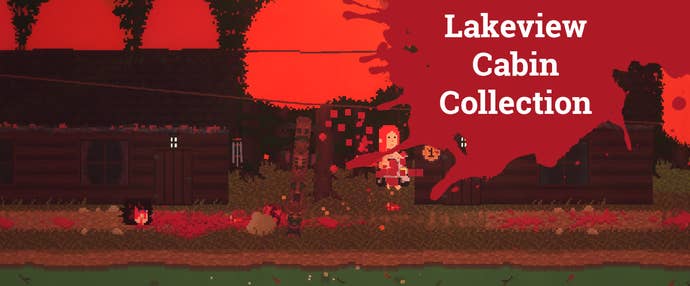
The first game we're highlighting also happens to be the only title that's already available: Lakeview Cabin Collection. In actuality, the game you can purchase on Steam or Humble Bundle right now is Lakeview Cabin III.
Lakeview's homage to Friday the 13th's Camp Crystal Lake is undeniably clear. The game is a sandbox, dropping you into the camp as one of four counselors setting things up for the upcoming summer season. From the onset, you wander around the camp, getting into drugs and alcohol, throwing things around, and generally making a fool of yourself. Until nightfall comes.
With night comes the killer, but the thing is, you have no clue what makes the killer come after you. You have no clue where the killer will appear. You enter a cabin or wander the woods, only to stumble upon axe-wielding death. And you die, moving on to the next camp counselor.
Lakeview is about experimentation. You can switch between your four characters at any time and each one can carry one object. Run, hide, build traps, find new items, work out new plans, die again. Will your faithful dog accidentally set you and the killer on fire? Will you trip over a shovel meant to slow down the murderer? Will you zipline right into a woodchipper? Death is the point of Lakeview, but each death is meant to be random and fun. It's a water cooler game, where you share your best death stories with your friends.
Creator Roope Tamminen is the sole developer on the title, which is an expansion of earlier browser games that he created. Tamminen was the first person I spoke to on the topic of slasher games, following Bob's great preview of Lakeview Cabin Collection. I wanted to understand his feelings on his creation and the slasher genre itself.

Why did you decide to make slasher game like Lakeview?
Tamminen: Weirdly enough, it reminds me of my childhood. My dad showed me the original Halloween when I was a kid and it scared the crap out of me! I still can't comprehend what he was thinking, showing a kid a movie like that, but it stayed with me. Before then, I had only watched these 'larger than life' adventure movies where the good always wins. So, it naturally fascinated me how a whole movie could be made about solely killing teenagers.
After the initial shock wore off, I started watching a lot more of the older horror movies. After all the tropes and clichés became obvious, I just started enjoying them even more. It's fun to predict who dies first and how. They are just dumb fun to me these days and in a way Lakeview Cabin is a celebration of all those movies, and all the evenings I spent with my dad watching them.
You're a bit different from the rest because you decided to go the horror-comedy route. Why didn't you play it straight?
Tamminen: I hate to admit it but it's just easier to me. I'm not saying I'm lazy but not taking it too seriously allows me to cut corners where I couldn't if I tried to make it serious. For example, I didn't give the characters any personality so the players don't get too attached, and might instead laugh at the horrors that happen to them. I also try not to polish the physics too much to maintain that accident-prone gameplay.
So it's a by-product of the fact that I do everything by myself, from programming and graphics to sound and music. I just have to let some stuff slide so I can actually get a finished product out. I'm just lucky it works out nicely for this project since it's supposed to have that 'shoestring budget' feel.
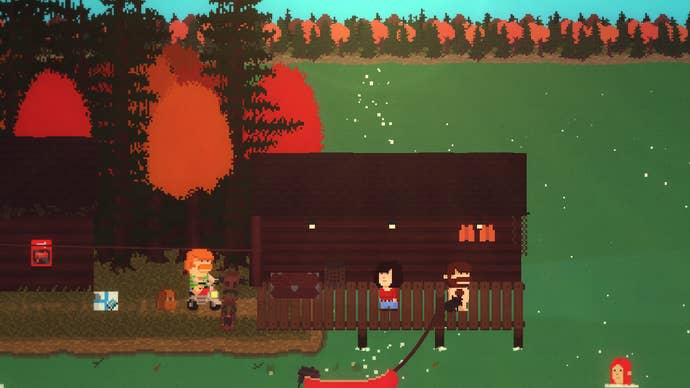
My guess is Friday the 13th, but what's your favorite horror film?
Tamminen: I still pop in the original Halloween from time to time. As I stated before, it holds a special place in my heart even to this day. It's such a pure example of it's genre. Michael Myers is just an epitome of evil and the movie doesn't need a convoluted plot to be effective. Then you have the superb soundtrack by John Carpenter that still hasn't been topped. Slasher movies don't get any better than that.
What are the building blocks of a great horror game?
Tamminen: One of the most important traits for a game developer is the ability to predict how the player will react to certain situations. You have to know what button they are most likely to push first even without any tutorial screens. Will they take the route to the right or left? You can control this behavior by leaving small breadcrumbs for them to find while still maintaining the illusion that they are completely in charge.
If you do it right, you will know where the slumps of the game are. So you know when the player is most likely to be relaxed or tense. And this is an especially important tool for horror games where you're looking to scare the player. It allows the developer to hit the player where it counts when they aren't even looking. So the key is to puppeteer the player towards an inevitable heart attack without their knowledge.
After years of nothing, slashers are making a big come back in the gaming industry. Why do you think that's the case?
Tamminen: To me, the supernatural monsters and urban legends that seem to inhabit most of the popular horror games of today are just starting to feel too distant. I get bored easily when the enemy you're facing is something out of this world. Even while a mask-wearing axe-killer might seem like something that we only see in movies, it's still undeniably tied to the real world. And that's always scary.
It might also be the fact that it's still such an untapped genre in games and people are starting to realize it. You have decades of these movies that are filled with ideas that are just gnawed to death in films, but work wonderfully as game-mechanics. Everyone of us has at one point yelled at the screen when a dumb victim is obliviously walking into a dark room to be killed. So this is a change to finally take control of that victim and try to beat the odds. It's a very cathartic experience.
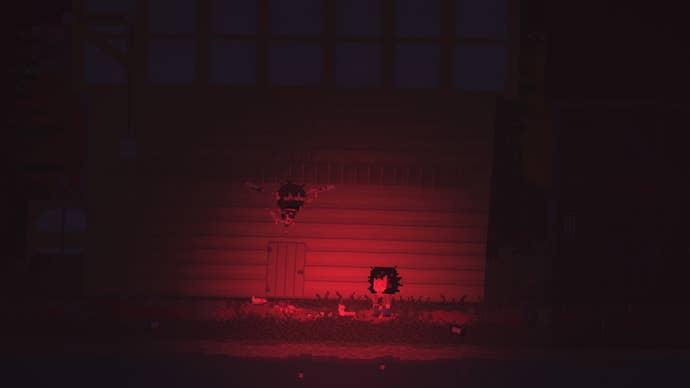
This is the first game you've charged players for. How has the reception for Lakeview Cabin III been versus your earlier titles?
Tamminen: The reception is basically the same as before. There's the good and the bad and I naturally get hung up on the bad like a good game developer should. What has changed though, is that since this is my first game that I'm asking money for, I have to treat the players as customers.
In the past if someone had a problem with my free games, I didn't lose my sleep because of it. 'It is what it is,' I said. Now I have to show a lot more respect to the players since they are basically feeding my kid. So I try to go out of my way to solve the problems the players might be having with my game. It's actually really rewarding though, so I'm happy things are as they are right now.
What are you planning for the upcoming follow-up games? How can you expand what you've already released and is there any part of the core game you're looking to change?
Tamminen: The core game will stay the same. You can change characters in all the upcoming sequels and there will be something out there to kill you. That's about it.
I'm not the kind of guy who wants to make the same thing four times in a row. So I'm really looking into ways to toy with the players expectations. For example, I'm hoping that a lot of players might delve in to the next episode with the mindset they have from the previous episode.
And they will soon learn that the planning and scheming that worked in the previous episode won't mean a rat's ass in the next one. The themes and the flow will change greatly with each episode. It's going to be a trail-mix of horror games when it's all said and done, and I really hope that players will be able to appreciate what I'm trying to achieve with it.
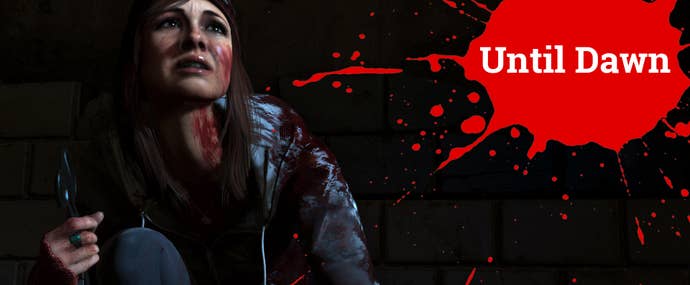
Until Dawn is one of the larger productions in the upcoming slasher-based games. The title was originally announced as a PlayStation 3 game with Move support, but developer Supermassive Games is now putting everything they have into creating a PlayStation 4 exclusive.
Until Dawn is the story of eight people who spend the night in a cabin in the remote Blackwood Pines. The evening in question marks the anniversary of death of a departed friend. Of course, various personal relationships come to a head when you're stuck in one place with a group and that's before you get to the serial killer who's trying to pick them off one-by-one.
Like Lakeview Cabin, Until Dawn is a single-player experience, but it's one that you're meant to experience in linear fashion. The game's Butterfly Effect system means that when you make a choice, it reverberates forward, creating unforeseen consequences. Not all eight characters will survive the night, but it's up to you to guide as many as possible through this horrific ordeal. Until Dawn also wants to keep you honest, so the game has a strict auto-save system to prevent you from reloading before key decisions. Once a character dies, they're dead, buddy. Move on.
The switchover from PS3 to PS4 also came with it a new third-person perspective, so you can watch the cast fight to survive, instead of tackling the fear directly from a first-person point-of-view. That cast includes Nashville's Hayden Panettiere, Agents of SHIELD's Brett Dalton, Night at the Museum's Rami Malek, Meaghan Martin, Nichole Bloom, Jordan Fisher, Galadriel Stineman, and Noah Fleiss. If you're going to do extensive performance capture, you might as well show it off.
Until Dawn executive producer Pete Samuels was kind enough to talk about the game and the genre.

Why did Supermassive Games decide that a survival horror game was its next project?
Samuels: "Survival Horror" is a label that doesn't quite fit. Almost, but not quite. Sure, it's a horror story where the clear aim for the player is to have the protagonists survive, but it's a potentially misleading label. "Survival Horror", based on what people have seen in games previously, doesn't define Until Dawn.
As a genre, horror appealed to us as a means of delivering extremes in emotional reaction. The concept of dealing with the most base of emotions, fear and survival, and putting player's through that with challenging moral dilemmas and the ability to create their own version of the story through the decisions they make, was irresistible.
Fair enough. Why did the team decide to go with a slasher game?
Samuels: The premise of the typical slasher was interesting because it was something that people would find familiar, something that we could therefore subvert and use to surprise the player. "Slasher" is a label that people have attached to Until Dawn from what they've seen thus far. Everything that people have seen would naturally lead them to that conclusion, but it is another definition that won't entirely define Until Dawn when people experience the whole thing. We've always maintained that, in Until Dawn, not everything is as it seems.

The stated aim of Until Dawn is to create a "playable horror movie". How do you decide where to land on the line between movie and game?
Samuels: That's such a good and important question. The key word in "playable horror movie" is "playable", not "movie". What Until Dawn is striving to be is world-class within the specific genre of 'interactive drama'. It's been important to us that the player's judgment, speed and skill will be tested throughout in the context of an engaging story played out in a stunning set with believable emotional performances from our cast.
When we say "playable horror movie", that's what we mean. The judgment element of the gameplay is geared towards the player's determination of a given situation, and how they choose to respond to it, and whilst the skill and speed tests are delivered in branching set-piece situations, success and failure will determine the way in which the story plays out. Ultimately, the fate of each of the cast.
The player's 'score' is determined by how many of the cast live or die over the course of their story, which is inextricably connected to the player's skill and judgment. As we know, there are all types of gamers and they like all kinds of different things in their games, so no single game can be everybody's cup of tea, but alongside the skill/speed/judgment dimensions of gameplay we've incorporated elements of meaningful exploration and collection that fit with into the overall tone of mystery and horror.
The Butterfly Effect system means that not every character will survive the log cabin experience and auto-saves prevent jumping back in the title. Why is permanent death such a major part of the experience?
Samuels: At a really early stage permanent-death became a major driver for us. The fact that mistakes or misjudgments are non-trivial, because you can't just try again, provides the player with a similar anxiety that they'd feel when watching a tense horror or thriller movie. We felt that the sense of permanent vulnerability would add significantly to the overall fear and dread. It was a tough design challenge though.
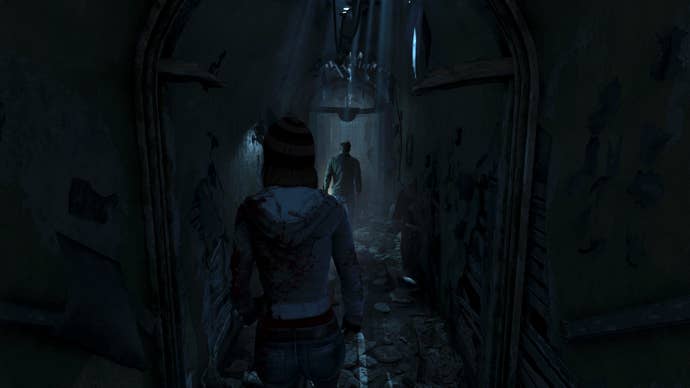
It was also important that the player's Until Dawn story was a similar length, and just as engaging and enjoyable, regardless of who lived and died during the course of the night. We've created content that covers all possible scenarios, and this means that there is a huge amount that no single player will see on a single play-through. That's what makes each player's story and outcomes so different.
What makes Until Dawn different from all the other slasher games that are coming? It's getting crowded out there.
Samuels: I think that the level of immersion in the story and its scenarios will make Until Dawn different within the genre of horror games. That's partly due to the believability in its sets and performances, its cinematography, and its when-you're-dead-you're-dead game structure. I would be hard pushed to think of any other game out there that is like this. There are levels of engagement above and beyond the 'normal' that make Until Dawn truly unique in this space.
Making a life and death decision in the heat of the moment that will permanently affect the story that you play has proved a very powerful device. Having a protagonist's character arc measurably changing and adapt based on the choices you play is entirely unique in this genre. A character can end up a hero or a jerk or even a dead jerk by the end. Because all of this affects your outcome, effectively your 'score', it's a differentiating game mechanic as much as it's a storytelling mechanic.
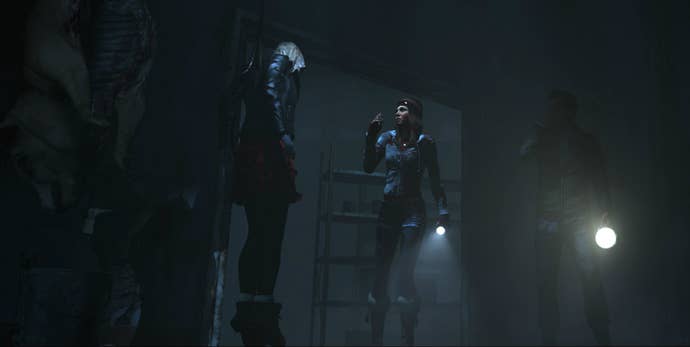
What was behind the decision to go with extensive actor capture?
Samuels: The extensive actor capture was part of an overall style choice for Supermassive. Realism is important to us as an aid to immersion, and any other method used to deliver emotional reactions in the characters and realism in the game's scenarios would have clashed with that. The style we've chosen is the one that most strongly supports the aim of "playable horror movie" and better enables the player to immerse themselves in that fantasy.
What's required to really scare players and how are you making sure that's a big part of Until Dawn?
Samuels: Fear is generated by taking the familiar and safe and rendering it vulnerable and fragile. Horror comes from adding a dark peril to that fragility. The vulnerability comes from trapping, isolating and incapacitating the group early on and then injecting the horror.
Like most horror movies, we've used the concept of night as a way to incapacitate the group. It's dark. It's very deliberately dark. Making a video game dark is much trickier than you'd think. You can't just turn the lights down or it would become unplayable. We've had to go call in some very traditional cinematic techniques and tricks using camera exposure parameters to mimic the chemical reaction of film stock and create that feeling of dread and darkness while still being able to see enough to understand what is going on.
Until Dawn definitely broadens the range of what horror games can be. The three key elements of Terror, Horror and Disgust must exist in a proportion that's appropriate to the tone of the horror we're making, and we believe that we've got that balanced pretty well in Until Dawn. The most important, the Terror, is that feeling of dreadful foreboding. The fear of the unseen. Maintaining that in the right proportion is probably where we've put most effort because it's the most difficult tone to do well. It can't be there continuously, so we break the tension with some lightness from time to time before we hit the player with some more.
Horror's there too, and that's the fear of the visible threat. In our case, that's the killer and the killer's 'tools'. Then there's the Disgust, gore if you like, which serves as the infrequent, but memorable reminder of the frailty of human flesh. It's to be used sparingly, certainly for the tone that we're aiming for in Until Dawn, so the key word for us in relation to Disgust is "memorable". As gross as it is, for many who enjoy this type of horror, the Disgust is a big part of the pay-off.
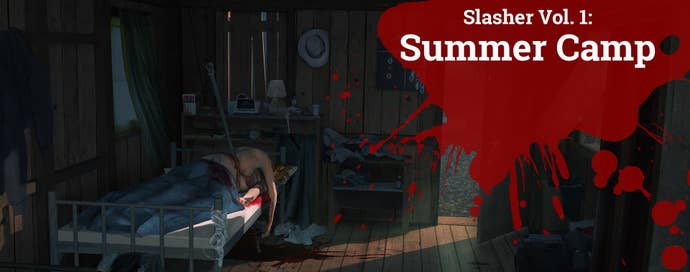
The final spotlight is on Gun Media's Slasher Vol. 1: Summer Camp, which seems like an odd title coming from the people that brought you Breach & Clear. The thing is, the folks at Gun Media are huge horror fans and that love is feeding directly in Summer Camp.
Summer Camp is third-person survival horror title taking place at Camp Forest Green. We don't know much about the game's details, because the developer is keeping things behind closed doors, but we do know it's designed to be an asymmetric multiplayer experience. That means Summer Camp pits 6 to 8 players against each other as either teen camp counselors or the killer, not unlike Turtle Rock's Evolve.
From the teaser trailer (shown below), it's clear that Summer Camp eats and breathes 1980's horror tropes. The entire thing mimics the low-budget, VHS-style feel we all remember from back in the day. The game also benefits from the veterans of that era: Jason himself, Kane Hodder, is handling the motion capture, composer Henry Manfredini is on the soundtrack, and special effects legend Tom Savini is the game's executive producer and cinematographer. Those are pretty big names in the genre and they're lending their expertise to this project.
Summer Camp co-creators Wes Keltner and Ronnie Hobbs sat down with me for a phone chat about the game. Well, about the stuff they're willing to talk about right now. (E3 is coming!)
The slasher genre has been pretty dead for a decade. Why are you doing Summer Camp now?
Hobbs: The slasher genre never actually went away, it just kind of went underground in the early 2000s. For video games, I think the longer something doesn't exist, the more you want it. Especially when that thing that doesn't exist is something you grew up on. Both Wes and I grew up watching slasher films. It dominated our childhood along with video games. You keep waiting and waiting for something, but it never gets made. That was our primary motivation. 'Why doesn't this exist? Can we do it?' We felt we could.
Keltner: With the landscape of gaming as a whole, it seemed like the right time. Especially for asymmetrical multiplayer. We were seeing some titles released that fit that. It's actually a game that Ronnie and I have been talking about for at least ten years. Either the tech wasn't quite there or the concept of a multiplayer-only thing. Would gamers even connect with that and want it? I think we're seeing more and more games that are like that. Even if they're not asymmetric, they're just multiplayer-focused; seeing those take off and do well, we think now is the time.
Your first trailer leaned heavily on the 80s slasher visuals. What's the exact tone you want the game to have?
Hobbs: We wanted to come out right away and let people know this was a homage to 80's slasher films. I think we achieved that. You watch that trailer and you know right away that it looks 80's. We knew what we were talking about when we designed every aspect of it. Our tone will still be dark and serious, but like any good slasher movie, there's a sense of not taking yourself too seriously.
Keltner: Self-aware is what I think a lot of those slasher films were. If you take some of the largest film franchises, they were all pretty self-aware of their own brand and tone. What I was pretty militant on around here was I didn't want a modern take on a slasher experience. I wanted everything to have the look and the feel that personifies that 1978 to 1989 time frame, which is when slasher films were king. And 'king' is an understatement. Slasher movies around '83-'84 were making more money than blockbuster movies were.
I wanted to go back to that time frame. Not only the tone, but the actual film aesthetic. A lot of those films had low-budgets, crappy technology in terms of their cameras, limited lighting if they could even afford it; all that played into what the end result was. On top of that, most of those films saw their money from VHS. When you're transferring from film grade down to VHS copy, the quality took a hit. That added to the effect, it added to the atmosphere. We want to capture all that for our title.
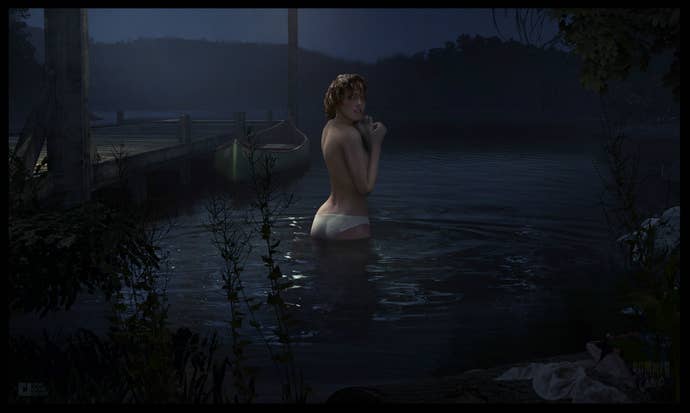
What makes great horror?
Hobbs: The first thing for me is unpredictability. The player has to feel uncomfortable. If the player is comfortable, they won't be scared. Silent Hill approaches it in a different way than Resident Evil. Resident Evil makes you feel uncomfortable with jump scares and big behemoth monsters. Did you play Amnesia: The Dark Descent?
Yeah.
Hobbs: Anytime you open a door or solve a puzzle, there's random element to the game creating monsters or not. Every time you go to open a door, you're worried that they're going to hear you. Even though they're scripted moments, they seem unscripted. If the player knows it's about to happen, then you start to anticipate it and it becomes more comfortable.
Atmosphere is the second one. My favorite quote about horror movies is 'The only thing scarier than something is nothing.' That's completely Silent Hill. If you go overboard in the blood and gore, you start to skew towards an action game, which is what Resident Evil has done recently. There's a reason Fatal Frame and Silent Hill hang around forever, while other games have faded off into oblivion. They do a great job of not showing what could harm you. The flipside of that is you have to have positive reinforcement.
The last thing is characters. There's a reason Pyramid Head and James are remembered. And there's a reason you forget the main characters in the Suffering for example.
Keltner: There's nothing that we can do from a design perspective, mechanics or otherwise, that will ever be scarier than the player's imagination. If you give them the tools to connect the dots, the line that they draw will be far scarier than if I laid that line out for them. That's crucial to any horror experience. Less is more.
What films or other media heavily influenced the style you're putting into Summer Camp?
Hobbs: I think one thing we figured out as we started making this project and bringing other people onboard: horror means something different to everybody. Wes likes different horror movies than I do. We all have an upbringing that's different from the person next to you. The first horror movies I saw were not the typical slashers. The kid down the street would get these import Italian horror films, the Giallo-brand of horror. Like Blood and Black Lace, Twitch of the Death Nerve, and Suspiria. They were so crazy and exotic that you had to import them, because they wouldn't allow you to rent them. I saw those before I saw any American slashers. Slashers from all over the world.
Keltner: You mentioned Twitch of the Death Nerve, there's a kill scene in there that was replicated in one of the Friday the 13th films. If you watch them side-by-side, frame-by-frame, it's almost identical. We paid homage to that in one of the pieces of concept art we released. Ronnie has a more import, arthouse approach and I came on board when it was more of the Hollywood, polished franchise approach. Friday the 13th, Nightmare on Elm Street, Halloween; those types of films. That was my childhood. More self-aware, more campy in nature. It was how creative were the kills that got people back into the box office to see those movies. That's ripe for gameplay mechanics.
Hobbs: Jason got people in to see the kills. Whereas the Italian ones before that chased you out of the theatre because it was all psychological. You were horrified at what you were seeing and you wanted to leave. But you wanted to see how Jason was going to kill some teenagers. Completely different approaches.
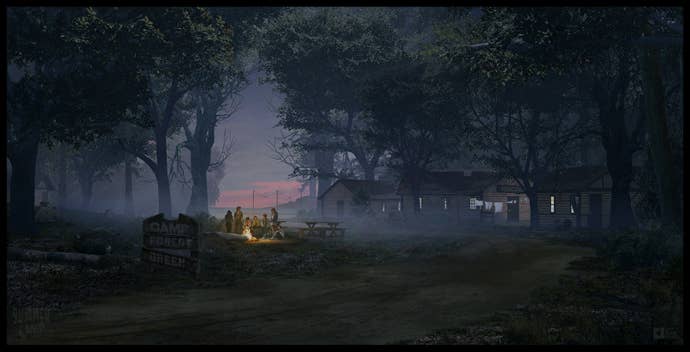
The serial killer in question is usually bigger than those he or she kills. What are you putting into creating a new horror icon?
Hobbs: That's why we hired Tom Savini. His role in the project is creating that. A lot of that falls in his wheelhouse. We're keeping that close to our chest until he's done.
Kane Hodder, Tom Savini, and Harry Manfredini are horror legends. How did you go about bringing them into the Summer Camp project?
Keltner: Ronnie and I know a little bit about horror, Ronnie probably more than I do, but I knew if you surround yourself with smart people, you're going to accomplish your goals much faster. I knew that the horror audience respected those three individuals and the knowledge that they're going to bring to this project is far greater than what Ronnie and I and the rest of the team could do by ourselves. Gameplay mechanics, we got that on lock down. It's the finer points to horror. The tips and tricks that Tom Savini has created over the years. Practical effects. He was the guy. He defined the 80's and early 90's in terms of horror. Anyone can do a jump scare. It's some of the finer points and experienced hand that Tom brings.
Now Kane, he was the one that brought personality to Jason. He was the one that pushed that unrelenting force. Kane is also a stunt coordinator, so he's got a really good eye for what's required to really sell that type of brutality and fear. He and Tom, hand-in-hand, will be doing these motion capture sessions. Kane will not only be suited up for the motion capture, but the rest of the stuntmen that he's bringing in. We're not just using motion capture actors, we have to use stuntmen because of how brutal these scenes will be. A normal actor can't take that much physical abuse, but stunt guys can. If we're going to motion capture someone being picked up and throw through a cabin window, Kane knows how to do that and sell it the right way.
Lastly with Harry Manfredini, he has a 128 some odd film credits to his name. He's created the sound for the Friday the 13th series. He's the only one of all the composers I did research on, when I listened to his stuff, it was unique. It had this 80's feel to it. I told him about the project and he immediately got it. He started sharing stuff with us that was absolutely on brand for what we wanted to accomplish.
What do you think is behind this proliferation of slasher games?
Keltner: You can call it some zeitgeist of collective consciousness. In the industry, there tend to be trends that sort of just happen. It happens in Hollywood, it happens in books and television. Things like the superhero trend in film and television. Why is it all of a sudden that slashers have started to show up in gaming? I think one of the reasons is a similar story to the one Ronnie and I had: it's something that made up our youth and we're now in positions that allow us to bring that experience to life. There's some of that. There's probably other factors you can point at, like Evolve launching and people loving the asymmetric experience. It's difficult to make that prediction.
How do you plan to differentiate yourself in a field that's becoming crowded?
Hobbs: Our main goal is to stay true to the source material. You can't fake horror. A game is scary or it's not. Right away, we want to stay true to the slasher genre. We hope our gameplay design is the thing that pushes us away from our competitors, which we'll talk about more later. Stay true to the source material, do it right, and make sure you know your s**t. The rest will take care of itself.












